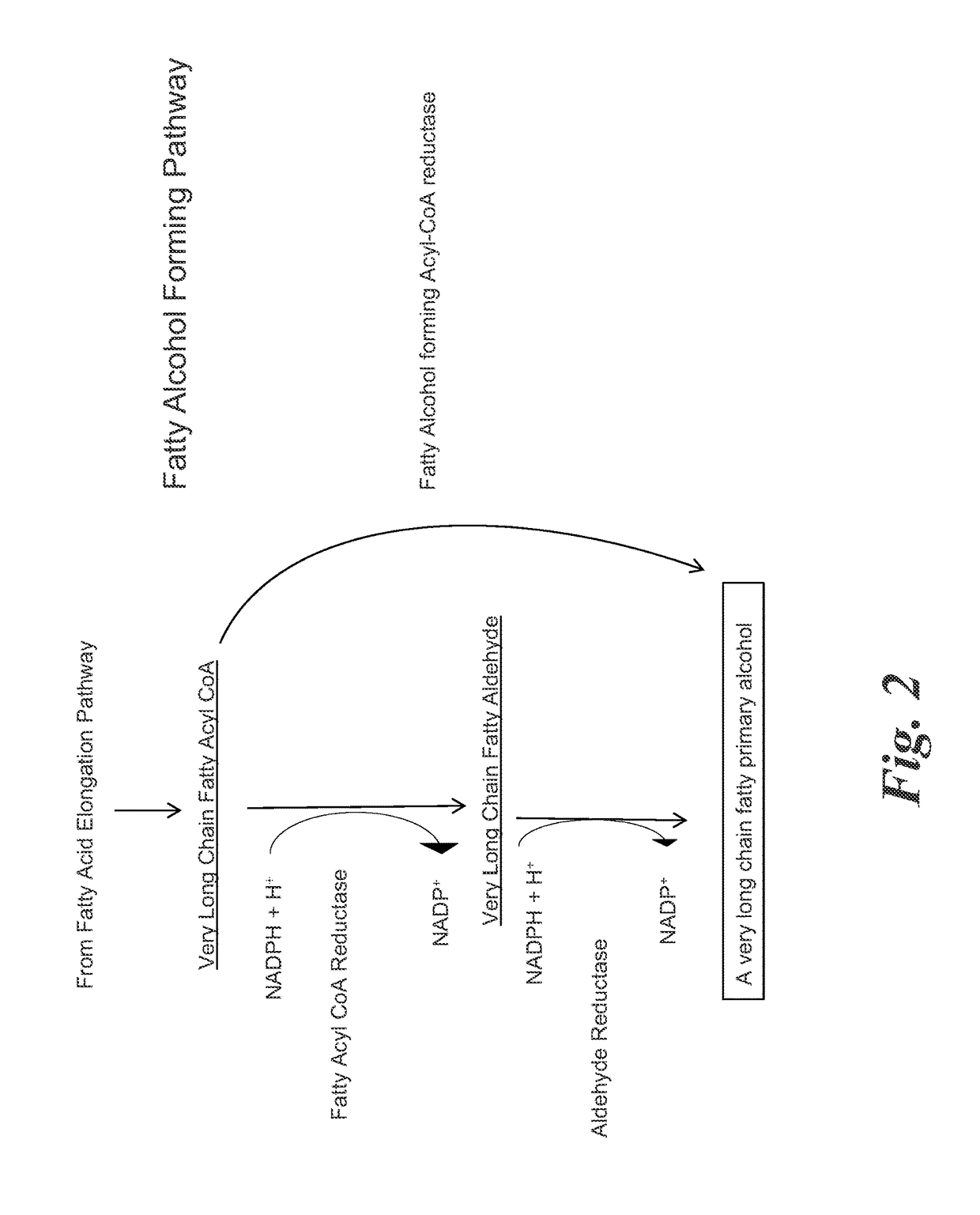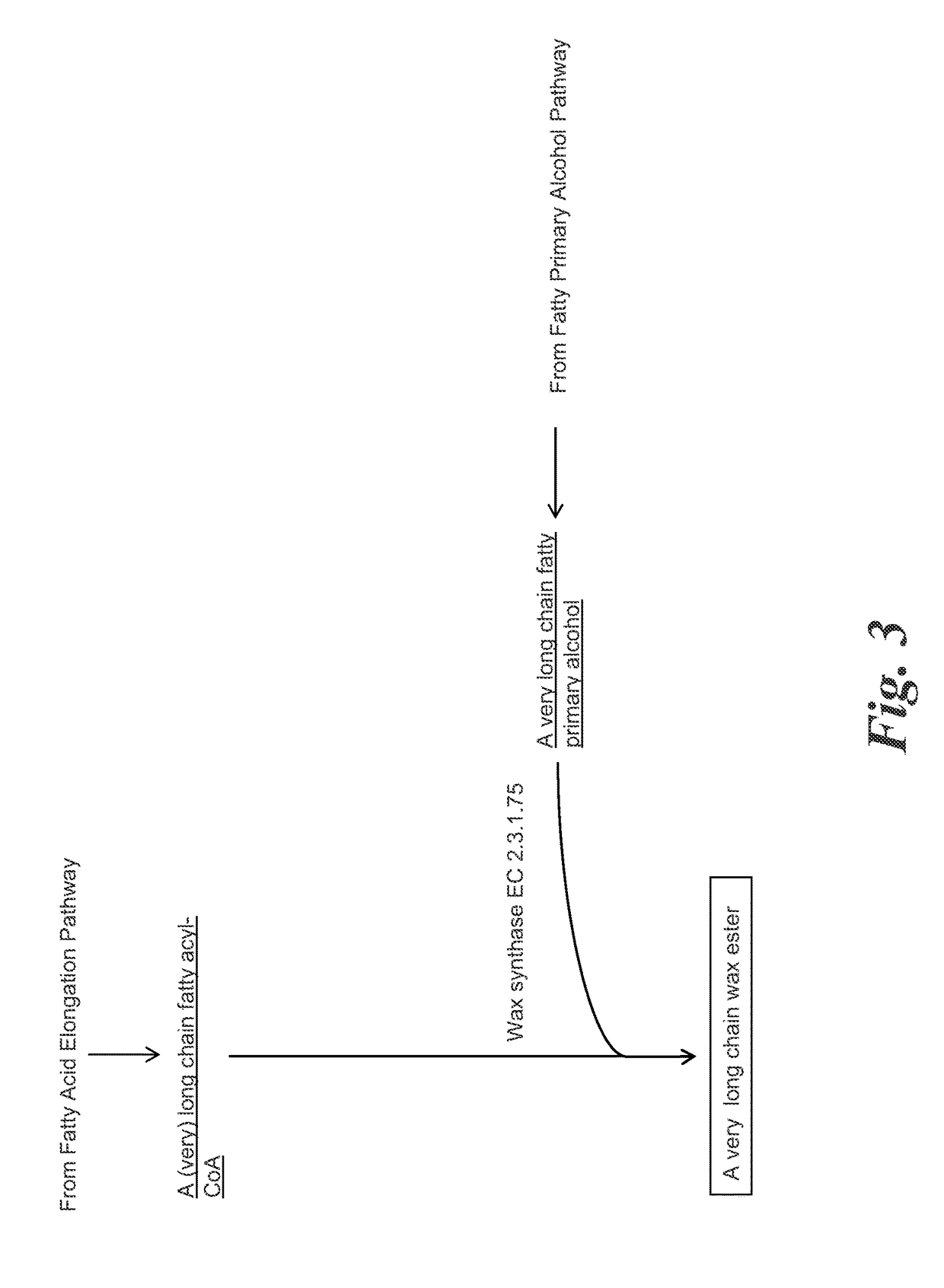Methods for biological production of very long carbon chain compounds
a carbon chain compound and biological technology, applied in the direction of enzymology, waste based fuel, transferases, etc., can solve the problems of insufficient commercial demand for insufficient supply of very long fatty acids from natural sources and chemical synthesis, and insufficient production of very long fatty acids for commercial needs, etc., to achieve the effect of reducing the cost of starting materials, reducing the conversion efficiency of carbon compounds, and reducing the cost of production
- Summary
- Abstract
- Description
- Claims
- Application Information
AI Technical Summary
Benefits of technology
Problems solved by technology
Method used
Image
Examples
example 1
Lipid Extraction from C1 Metabolizing Microorganisms
[0227]A fatty acid oil composition contained within a harvested bacterial biomass was extracted using a modified version of Folch's extraction protocol (Folch et al., J. Biol. Chem. 226:497, 1957), performed at 20° C. (i.e., room temperature) and in an extraction solution made up of one volume methanol in two volumes chloroform (CM solution). About 5 g wet cell weight (WCW) of either fresh bacterial biomass (or bacterial biomass stored at −80° C. and subsequently thawed) was used for extractions. A 100 mL CM solution was added to the cell material and the mixture was extracted vigorously in a separatory funnel. After at least 10 minutes, three phases were resolved. The organic phase containing extracted lipids settled at the bottom of the separatory funnel, which was drained into a clean glass bottle. The middle layer contained primarily lysed cellular materials and could be separated from the light water phase containing salts and...
example 2
Fatty Acid Methyl Ester Conversion of Lipids from C1 Metabolizing Microorganisms
[0232]The lipid fractions extracted from M. capsulatus Bath, M. trichosporium OB3b, and Methylomonas sp. 16a culture biomass in the form of dry solids were individually hydrolyzed with potassium hydroxide (KOH) and converted into fatty acid methyl esters (FAMEs) via reaction with methanol in a single step. About 5 g of extracted solid lipids in a 10 mL glass bottle were dissolved with 5 mL of 0.2 M KOH solution of toluene:methanol (1:1 v / v). The bottle was agitated vigorously and then mixed at 250 rpm at 42° C. for 60 minutes, after which the solution was allowed to cool to ambient temperature and transferred to a separatory funnel. Approximately 5 mL distilled water and 5 mL CM solution were added to the separatory funnel, mixed, and then the phases were allowed to separate by gravity or by centrifugation (3,000 rpm, 25° C.) for 5 minutes. The top aqueous layer was removed, which contains dissolved glyc...
example 3
Stable Carbon Isotope Distribution in Lipids from C1 Metabolizing Microorganisms
[0236]Dry samples of M. trichosporium biomass and lipid fractions were analyzed for carbon and nitrogen content (% dry weight), and carbon (13C) and nitrogen (15N) stable isotope ratios via elemental analyzer / continuous flow isotope ratio mass spectrometry using a CHNOS Elemental Analyzer (vario ISOTOPE cube, Elementar, Hanau, Germany) coupled with an IsoPrime100 IRMS (Isoprime, Cheadle, UK). Samples of methanotrophic biomass cultured in fermenters or serum bottles were centrifuged, resuspended in deionized water and volumes corresponding to 0.2-2 mg carbon (about 0.5-5 mg dry cell weight) were transferred to 5×9 mm tin capsules (Costech Analytical Technologies, Inc., Valencia, Calif.) and dried at 80° C. for 24 hours. Similarly, previously extracted lipid fractions were suspended in chloroform and volumes containing 0.1-1.5 mg carbon were transferred to tin capsules and evaporated to dryness at 80° C. f...
PUM
| Property | Measurement | Unit |
|---|---|---|
| temperatures | aaaaa | aaaaa |
| wet cell weight | aaaaa | aaaaa |
| temperature | aaaaa | aaaaa |
Abstract
Description
Claims
Application Information
 Login to View More
Login to View More - R&D
- Intellectual Property
- Life Sciences
- Materials
- Tech Scout
- Unparalleled Data Quality
- Higher Quality Content
- 60% Fewer Hallucinations
Browse by: Latest US Patents, China's latest patents, Technical Efficacy Thesaurus, Application Domain, Technology Topic, Popular Technical Reports.
© 2025 PatSnap. All rights reserved.Legal|Privacy policy|Modern Slavery Act Transparency Statement|Sitemap|About US| Contact US: help@patsnap.com



